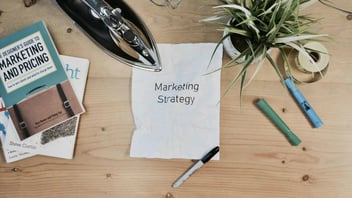Why PPC Advertising? Is it worth it?
PPC, or pay-per-click, is a digital advertising strategy where you pay a fee each time your ad gets clicked - and nothing else. Essentially, you are paying for targeted visitors to your website, app, or landing page.
One of the more popular forms of PPC is search engine advertising. Also called paid search, it allows advertisers to bid for the right to place their ads in a search engine's links when a potential customer performs a search related to your business. For example, if a customer searches for antiquarian books on Google, companies like Books Tell You Why may, through Google Adwords, bid for the right to show on top of the search results for 30 days.
.webp?width=799&height=449&name=Could-PPC-Be-the-Secret-to-Success-for-Immediate-Results%20(1).webp)
Why Use PPC?
In today's highly competitive business landscape, companies constantly strive to reach their target audience effectively and maximize their marketing efforts. One powerful tool that has emerged as a game-changer in the digital marketing realm is Pay-Per-Click (PPC) advertising. PPC advertising provides many benefits that can significantly enhance a company's marketing strategy.
PPC advertising allows companies to target their desired audience precisely based on demographics, location, interests, and specific keywords. This level of granularity ensures that marketing messages reach the right people at the right time, increasing the chances of conversions and generating qualified leads.
PPC advertising delivers instant visibility, unlike traditional marketing channels that require time to gain traction. Through platforms like Google Ads or social media ads, companies can quickly position their brand in front of a vast audience, driving immediate traffic to their website or landing pages.
So, what does a PPC campaign consist of?
PPC Campaign Elements
A PPC marketing campaign generally involves the following components:
-
Keywords: These are the words or phrases that trigger the display of your ads. You choose the keywords relevant to your business that you think users will search for when looking for products or services like yours.
-
Ad groups: An ad group is a set of related ads that share the same theme and target the same keywords. Each ad group can contain multiple ads with a unique message and landing page.
-
Ads: A PPC ad typically includes a headline, description, and display URL. The headline and description are the text users see when your ad is displayed, and the display URL is the web address shown with the ad.
-
Landing pages: A landing page is the web page users visit when they click on your ad. It should be relevant to the ad and contain information that will help convert visitors into customers.
-
Bid amounts: When you create a PPC campaign, you set a maximum bid amount for each keyword or ad group. This is the maximum amount you are willing to pay for each click on your ad.
-
Quality score: The quality score is a rating that Google assigns to your ads and keywords based on their relevance and the landing page quality. A higher quality score can lead to a lower cost per click and a higher ad ranking.
PPC Costs
PPC advertising undoubtedly offers a range of benefits for businesses, but it's essential to consider the costs involved in implementing and maintaining a successful PPC campaign. Several key factors drive the cost of a PPC campaign:
-
Keywords: The cost of keywords can vary greatly depending on the competitiveness of the market and the demand for the keyword. Highly competitive keywords, such as those related to popular products or services, can be more expensive to bid on.
-
Ad position: An ad's position on the search engine results page (SERP) can also affect the cost of a PPC campaign. Ads that appear higher on the SERP tend to have a higher click-through rate (CTR), which can increase the cost.
-
Ad quality: An ad's quality and the landing page's relevance can also impact the cost of a PPC campaign. Ads with a high-quality score, which is a rating assigned by Google based on the relevance and quality of the ad and landing page, can have a lower cost per click.
-
Industry: The industry in which a business operates can also affect the cost of a PPC campaign. Some industries, such as insurance and legal services, tend to have higher costs per click due to the high competition for keywords.
-
Geography: The location of a business can also impact the cost of a PPC campaign. Ads targeted to specific countries or regions may cost more per click due to the higher demand for those keywords.
You won't necessarily reach the appropriate budget or overall costs by trying to spend how and how much your competitors do. Remember, what you decide to do with a particular PPC campaign needs to factor in your existing marketing and its results from other channels. Analyze these factors to determine what you need to spend and which campaign will be most effective.
A small to mid-size company can expect to spend around $15,000 monthly with average cost-per-click rates.
Benefits of PPC
PPC advertising offers a range of benefits that can significantly enhance a company's marketing efforts. From targeted reach and immediate visibility to cost control and agility, PPC advertising empowers businesses to connect with their audience, drive traffic, and achieve tangible results. Let's explore some of the key advantages of PPC:
-
Immediate results: One of the most significant advantages of PPC is that it can produce almost instantaneous results. Unlike SEO, which will take time to show results, PPC ads can start generating traffic to a website immediately after they are set up. This makes it an excellent option for businesses that need to get their website in front of potential customers quickly.
-
Targeted traffic: PPC allows businesses to target their ads to specific keywords and demographics, which means they can reach those most likely interested in their products or services. This can result in higher conversion rates and a better return on investment (ROI).
-
Measurable results: With PPC, it's easy to track the success of an advertising campaign. Most PPC platforms, such as Google Ads, provide detailed analytics and reports that show how many clicks an ad received, the cost per click, and the conversion rate. This allows businesses to see what's working and what's not and adjust their campaigns accordingly.
-
Flexibility: PPC campaigns can be easily adjusted and modified to meet the changing needs of a business. For example, if a business wants to increase its ad budget or target a new group of customers, it can make those changes quickly and easily.
-
Cost-effective: One of the biggest benefits of PPC ads is that they're cost-effective; you only pay if someone clicks. For the same reason, you get fast, visible results from those clicks. PPC ads allow for laser focus on your ideal prospect and aren't affected by algorithm changes. While you shouldn't sideline your inbound marketing efforts, PPC can help you generate leads while your inbound strategies mature.
-
Brand visibility: PPC can help increase brand visibility and recognition. By placing ads on popular search engines and websites, businesses can get their brand in front of a large audience, even if they don't have a high organic search ranking.
-
Mobile advertising: With the increasing popularity of mobile devices, PPC can effectively reach potential customers on the go. Most PPC platforms offer mobile advertising options, allowing businesses to reach users through ads.
Looking for additional ways to generate leads? Try blogging!
How It Works
Now that you understand what a PPC campaign consists of and how it can benefit you, let's dive into the nitty-gritty of how PPC works:
-
The business creates an account with a PPC platform, such as Google Ads or Bing Ads.
-
The business selects the keywords relevant to its products or services that users will search for when looking for them.
-
The business creates ads that contain a headline, description, and display URL. The headline and description are the text users see when the ad is displayed, and the display URL is the web address shown with the ad.
-
The business sets a maximum bid amount for each keyword or ad group. This is the maximum amount they are willing to pay for each click on their ad.
-
When a user searches for one of the business's keywords, the PPC platform displays the business's ad and other sponsored listings.
-
If the user clicks on the business's ad, they are taken to the business's website (also known as the landing page). The business is then charged the amount of its bid for the click.
-
The PPC platform tracks the performance of the business's ads. It provides detailed analytics and reports on the number of clicks, the cost per click, and the conversion rate (the percentage of clicks that result in a sale or other desired action).
You can also choose from various ad networks, like Google Ads or Microsoft Advertising. Social media platforms like YouTube, Facebook, and LinkedIn also offer ad networks, as do Instagram and Twitter. Your choice of networks will ultimately reflect your target audience and campaign goals. Each network requires you to understand its unique strategy and how it relates to your campaign. Each also has different costs and bid optimization strategies.
Google Ads
The most popular network because of the billions of searches in the Google search engine. Google Ads display on more than 2 million websites and 650,000 apps. That lets you go wherever your audience might be. Depending on your industry, you may find Google Ads to have higher CPCs on your keyword searches. If so, you may want to consider another platform.
Microsoft Ads
Another behemoth in PPC advertising, this search network gets 12.2 million searches monthly. It also simplifies transferring your Google Ads campaign, making it very attractive if you want to move. However, it's better to avoid repeating your Google presentation exactly. Some adjustments will need to be made in your budget, matches, and any ad extensions you want to add. Microsoft serves Yahoo search traffic only. It can power different digital assistant voice searches and target your searchers using LinkedIn profile data, including company, job function, and industry.
In other words, if you're looking to reach currently employed Chief Compliance Officers in financial services, Microsoft can use LinkedIn data to find them. Only Microsoft (and LinkedIn) have access to this data. Its native content placement sites include Outlook and Edge. The cost relies on the competition and the ad quality.
YouTube
Over 2 billion users log into YouTube monthly, making it an excellent way to reach your audience. Campaigns are created on the Google ads platform with deeper information about demographics and engagement bias YouTube Analytics. YouTube offers shippable and non-skippable in-stream ads, bumper ads, masthead ads, and video discovery. Pricing is on a cost-per-view or cost-per-thousand (CPM) basis.
Facebook continues to be the top social network, with some 2.6 billion monthly users. And it has the advantage of not sending personal user data to foreign governments. Facebook allows extremely focused target ads based on demographics, interests, and other user factors analysis.
Furthermore, Facebook retargets by focusing on user activity on Facebook and through your pixel data and uploaded prospect lists. Facebook can place ads on Facebook, obviously, but also on Instagram, Messenger, and Audience Network. Facebook supports various formats, including video, single images, carousels, and slideshows. Costs are charged per the desired result based on your bid, estimated activity, and the quality of your ads.
Building Your PPC Campaign
Fortunately, for those of you just beginning PPC advertising, help is available. HubSpot Marketing tools, for example, allow building your campaign, including templates, guides, and planners. You can even download a free Google Ads PPC kit from HubSpot.
HubSpot is one of many options, of course. Adobe and Salesforce offer alternatives to HubSpot Marketing Hub, as does Sage CRM. Each of these vendors features different advantages and disadvantages. You must develop your PPC campaign goals before analyzing and selecting a program that will work for you.
Remember that your marketing may not be aimed simply at a high conversion rate and instant sales. You may be building a brand image and looking to concentrate on lead nurturing rather than immediate sales. PPC can work for either goal and should be a factor in your digital marketing plans.











Leave a Comment